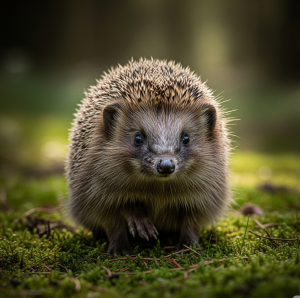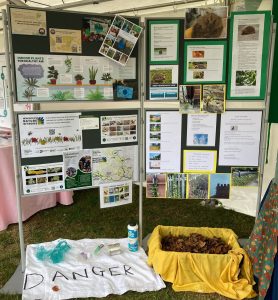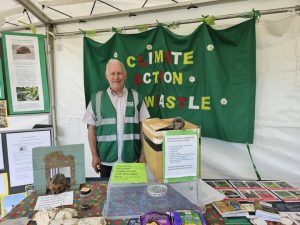


The Newcastle Mela, a vibrant celebration whose name signifies “meeting” or “gathering,” provided a magical backdrop for us to connect with the community this past Bank Holiday. Climate Action Newcastle’s stall was dedicated to the theme of “The Natural World in our City,” a powerful reminder that our living heritage thrives right on our doorsteps. The goal was to highlight the importance of urban biodiversity and empower everyone to take practical, local action.
The use of hedgehogs was chosen as our springboard, a beloved and iconic species whose decline serves as a poignant indicator of the health of our urban ecosystems. The conversations we had demonstrated how this simple entry point could open up a much wider dialogue about all urban wildlife—from the insects in our gardens to the birds in our parks. The stall emphasized that nature isn’t just found in remote wild spaces, but in the small corners of our daily lives, and that protecting it is a shared responsibility.
The core message was one of empowerment, and offered attendees a range of actionable steps. There was accessible information on why urban wildlife, and hedgehogs in particular, are struggling, and showcased the inspiring fact that urban hedgehog populations are faring better than rural ones, thanks to the small, collective efforts of individuals. There were tips for creating wildlife-friendly spaces through “Hedgehog Highways” in fences, building log piles for shelter, and choosing native plants that support local insect life. The stall also highlighted the importance of reducing harmful impacts by raising awareness of the dangers of pesticides and the threat that litter and plastic pollution pose to wildlife. It was wonderful to see so many people enthusiastic about taking these steps in their own gardens and communities.
In addition to our key messages, the stall was a hub of activity. Children also enjoyed creating their own cards using urban wild life colouring in images and took home seeds for window sill growing, a perfect way to start their own journey into urban biodiversity. The event was a testament to the strong synergy between urban biodiversity and climate action; after all, healthy ecosystems are more resilient to climate change. Climate Action Newcastle’s presence at the Mela served as a tangible, local entry point for a critical global conversation.
For the CAN volunteers the event offered a strong sense of purpose, having successfully raised awareness, educated attendees, and inspired pledges for specific actions. CAN also collected a great number of contacts for future workshops and volunteer opportunities. The collaboration was a great success, and we’re excited to continue engaging with the community and strengthening these vital partnerships.
Hedgehog Dos and Don’ts: Creating a Safe Haven
To help protect our prickly friends, here are some simple guidelines for making your garden a safe and welcoming space for hedgehogs.
Do:
Create a “Hedgehog Highway”: Cut a small hole, about 13cm x 13cm, at the base of your fence or wall. This allows hedgehogs to roam freely between gardens in search of food and mates, as they can travel over a mile a night.
Provide Food and Water: Leave out a shallow dish of fresh water, especially during dry spells. You can also offer a small amount of kibble or dry cat food (not fish-based).
Offer Shelter: Provide a purpose-built hedgehog house, or create natural shelters using a log pile or a pile of leaves and sticks. This gives them a safe place to rest and hibernate.
Be a Tidy Gardener: Keep your garden clean and free of litter, as hedgehogs can easily get tangled in plastic rings, netting, and other rubbish.
Check Before You Mow: Always check long grass, log piles, and bonfires for hedgehogs before you use a lawnmower, strimmer, or light the fire. They often hide in these spots and can be seriously injured.
Don’t:
Leave out Milk or Bread: Hedgehogs are lactose intolerant and milk can cause them to become very ill. Bread is not a suitable food and offers no nutritional value.
Use Slug Pellets or Pesticides: These chemicals are highly toxic to hedgehogs and other wildlife. Slugs are a natural food source for hedgehogs, so by eliminating them, you’re also eliminating their food. Opt for natural pest control methods instead.
Garden with a Tense Netting: Avoid using fruit netting or other mesh materials at ground level, as hedgehogs can easily get their heads and legs trapped.
Leave Out Food for Other Animals: Do not leave large bowls of food for other animals (like dogs or cats) outdoors, as this can attract hedgehogs and encourage them to rely on an unhealthy food source.
Disturb a Hedgehog’s Nest: If you find a hedgehog nest, leave it alone. Disturbing a nest, especially during hibernation or when there are young hoglets, can cause the mother to abandon her babies.
What to Do if You See a Hedgehog During the Day
Seeing a hedgehog out and about during the day can be a sign that it’s in trouble. Hedgehogs are naturally nocturnal, so a daytime appearance, especially if it seems lethargic, wobbly, or has visible injuries, is a red flag. If you come across a hedgehog in this situation, it’s important to act quickly and carefully.
Observe from a Distance: First, watch the hedgehog for a few minutes to see if it’s moving normally or if it seems unwell. It could be a pregnant or nursing female foraging for food, so if it looks active and healthy, you can leave it be. However, if it’s sunbathing, stumbling, or has flies buzzing around it, it likely needs help.
Safety First: If you determine the hedgehog needs assistance, approach it gently and wear thick gloves to protect your hands. You can use a towel or a small blanket to pick it up and place it in a high-sided box (like a shoebox) with some newspaper or an old towel for bedding.
Provide a Safe Space and Warmth: Move the box to a quiet, safe place away from pets and young children. You can offer a shallow dish of water and a little bit of kibble or dry cat food, but do not try to force it to eat or drink. If the hedgehog seems cold or unwell, providing warmth is crucial.
Using a Hot Water Bottle: A hot water bottle is an excellent way to provide warmth for a sick or injured hedgehog, as they are susceptible to hypothermia and shock.
Wrap it carefully: Never place a hot water bottle directly in the box with a hedgehog. Always wrap it in a thick towel or old blanket. This prevents the hedgehog from being burned by direct contact.
Provide space to move away: Place the wrapped hot water bottle at one end of the box. This allows the hedgehog to move towards or away from the heat source as it needs to, preventing it from overheating.
Keep it warm: It is vital that the hot water bottle remains warm. If it’s allowed to go cold, it will have the opposite effect and can chill the hedgehog further, doing more harm than good. You should check and replace the water as needed.
Seek Expert Help Immediately: It is crucial to contact a local wildlife rescue or a hedgehog specialist as soon as possible. They will be able to provide the necessary care and treatment.
Where to Get Help in Northeast England:
For help with an injured or unwell hedgehog in Northeast England, you should contact a specialist rescue center. Here are some options:
Pawz for Thought (Sunderland): A very active charity that rescues, rehabilitates, and releases hedgehogs and other wildlife across the North East.
Blyth Wildlife Rescue: They operate across the North East and are experts in hedgehog care.
Durham Wildlife Trust: While they may not offer direct rescue services, they can provide advice and put you in touch with local rehabilitators.
The British Hedgehog Preservation Society (BHPS): Their website has a comprehensive list of independent hedgehog rehabilitators across the country. You can use their “Find a Rehabilitator” tool to locate one near you.
Remember, prompt action can make all the difference in a hedgehog’s recovery.

